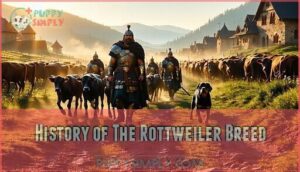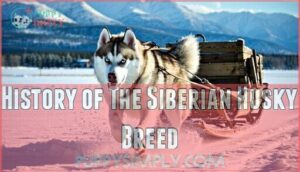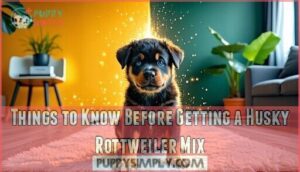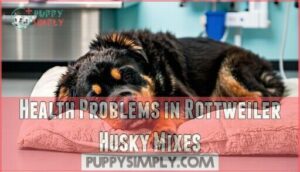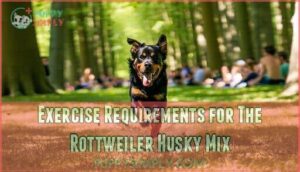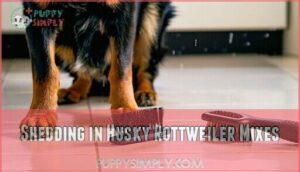This site is supported by our readers. We may earn a commission, at no cost to you, if you purchase through links.
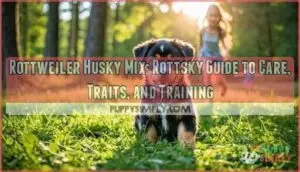
This hybrid inherits the Rottweiler’s loyalty and protective nature, paired with the Siberian Husky’s energy and stunning looks.
They’re strong, intelligent, and full of spirit, making them a handful for inexperienced owners but a joy for active families.
Expect a medium to large dog with a double coat, shedding that keeps lint rollers busy, and a personality that thrives on exercise and mental stimulation.
Proper training and socialization are key to handling their strong will.
Curious about their diet or training tips? There’s more to explore!
Table Of Contents
- Key Takeaways
- Appearance and Personality of The Rottweiler Husky Mix
- Physical Comparison of The Rottsky
- History of The Rottweiler Breed
- History of The Siberian Husky Breed
- Things to Know Before Getting a Husky Rottweiler Mix
- Health Problems in Rottweiler Husky Mixes
- Exercise Requirements for The Rottweiler Husky Mix
- Shedding in Husky Rottweiler Mixes
- Best Diet for a Husky Rottweiler Mix
- Training Tips for The Rottweiler Husky Mix
- Frequently Asked Questions (FAQs)
- What is a Siberian Husky Rottweiler mix?
- Should you buy a husky Rottweiler mix?
- Is a ROTT husky mix a good dog breed?
- What should I get my Siberian Husky Rottweiler mix?
- Is a Rottweiler-husky mix a good family dog?
- Is a husky Rottweiler mix a good dog?
- Are Rottskys easy to train?
- What is the temperament of a Rottsky dog?
- What is the rarest husky mix?
- What is the average cost of a Rottweiler Husky Mix puppy?
- Conclusion
Key Takeaways
- You’ll need to commit to early training and socialization to handle the Rottsky’s intelligence and stubborn streak.
- Regular exercise, at least 1.5 to 2 hours daily, keeps their high energy levels balanced and prevents destructive behavior.
- Be ready for heavy shedding due to their double coat, requiring routine grooming especially during seasonal shedding spikes.
- A high-protein diet suited for their age and activity level supports their health and energetic lifestyle.
Appearance and Personality of The Rottweiler Husky Mix
Blending strength and charm, the Rottweiler Husky mix boasts a striking appearance and a unique personality.
Blending strength and charm, the Rottsky captivates with loyalty, energy, and stunning looks, making every moment unforgettable.
This medium to large breed, known as the Rottsky, often showcases coat variations ranging from black and brown to gray or rust.
Their eye color can be equally enchanting—icy blue, brown, or even a mix of both. With a muscular build and size differences leaning more in the direction of Rottweiler bulk or Husky agility, they’re undeniably impressive.
The Rottweiler Husky mix personality is a delightful mix of loyalty, protectiveness, and spirited energy. Grooming needs can be demanding due to their dense coat, but regular care keeps them looking sharp.
Their temperament traits combine affection with independence, making them a loving yet adventurous companion for the right owner. They also need significant exercise, requiring one to two hours of daily activity.
Physical Comparison of The Rottsky
The Rottweiler Husky mix boasts a striking blend of features from both parent breeds, offering endless variety in size, build, and appearance.
You’ll notice their size ranges from a compact 50 pounds to an impressive 100 pounds, with heights between 20 and 26 inches.
Their coat variations could reflect the Husky’s dense fluff or the Rottweiler’s shorter, sleek coat.
Eye colors steal the spotlight, often icy blue, brown, or even mesmerizing heterochromia.
Build types can lean muscular like a Rottweiler or athletic like a Siberian Husky.
Markings add uniqueness, with black-and-tan patterns or Husky-like combinations.
Owners should also be aware of their potential for common health problems, requiring regular vet visits.
Here’s a quick snapshot:
Feature Detail
History of The Rottweiler Breed
The Rottweiler’s story begins over 2,000 years ago with its Roman origins.
Descended from mastiff-type dogs, these powerful drover dogs accompanied Roman legions, herding cattle and guarding camps. After the Roman Empire’s decline, they settled in Germany, particularly in Rottweil, where their versatility shined.
They became known as Butcher’s Dog of Rottweil, highlighting their role in the livestock trade.
Here’s why they’re iconic:
- Roman Roots: Bred for strength and endurance, ideal for military and agricultural tasks.
- Rottweil Origins: Named after the German town where they thrived as herders and guard dogs.
- Drover Dogs: Essential for moving livestock across vast distances.
- AKC Recognition: Officially recognized in 1931, cementing their breed popularity.
- Modern Role: Known for loyalty, making them exceptional working and family dogs.
Their legacy blends strength, loyalty, and history!
History of The Siberian Husky Breed
The Siberian Husky’s story is as fascinating as its icy blue eyes.
Known for their legendary endurance, Siberian Huskies are unparalleled companions across frozen terrains, embodying strength, loyalty, and resilience.
Originating with the Chukchi Tribe in Siberia, these dogs were bred for endurance, pulling sleds across frozen landscapes.
Their strength and loyalty made them indispensable companions.
Fast forward to the early 1900s, and Huskies gained fame during Alaska’s Gold Rush, proving their worth in harsh conditions.
They became legends in the 1925 Nome serum run, delivering life-saving diphtheria antitoxin through treacherous terrain.
Modern Huskies still carry traits honed by centuries of breed development—speed, resilience, and a friendly temperament.
Whether on Alaskan sledding teams or as beloved pets, they embody a legacy of survival and teamwork that began with their Chukchi origins thousands of years ago.
A similar mix, the Gerberian Shepsky emerged in the 1990s.
Things to Know Before Getting a Husky Rottweiler Mix
Before bringing a Rottweiler Husky mix into your life, consider these key factors:
- Lifestyle Compatibility: Rottskys thrive in active households.
- Commitment Level: Their high energy and stubborn streak demand consistent training and attention.
- Space Requirements: Apartments aren’t ideal unless outdoor activity is guaranteed.
- Breeder Reputations: Always research breeders to avoid unethical practices and guarantee a healthy pup.
They need space to roam and at least two hours of daily exercise to burn off energy.
This loyal, powerful mix isn’t for the faint-hearted! They’re known for their unwavering loyalty to their families.
Health Problems in Rottweiler Husky Mixes
Your Rottsky may inherit health problems like hip dysplasia, eye issues, bloat risk, joint problems, or autoimmune diseases.
Regular veterinary checkups and genetic testing can help catch Rottweiler Husky mix health concerns early.
Feed high-quality kibble with glucosamine for joint care, and watch for sensitive stomachs.
If you notice limping, lethargy, or odd behaviors, don’t delay a vet visit—prevention beats cure.
As a larger breed, they often weigh between 40-110 pounds, so proper diet is key.
Stay proactive about Rottsky health issues, and you’ll enjoy years of adventures with your loyal, energetic companion!
Exercise Requirements for The Rottweiler Husky Mix
Keeping up with the exercise requirements of a Rottweiler Husky Mix can feel like managing an athlete’s training schedule. Rottsky exercise needs are high due to their energetic nature, requiring about 1.5 hours of daily activity.
This should include a mix of long walks, leash training, and off-leash activities such as running or hiking in safe spaces. Mental stimulation is just as essential—think puzzle toys, short training sessions, or interactive games to prevent boredom.
Exercise intensity matters too; balance vigorous activities with lighter play to avoid overexertion. High-energy dogs like this thrive on routine and variety.
A rottweiler husky mix, also known as a Rottsky, typically has a lifespan of 9-13 years. If left restless, they may channel energy elsewhere—like chewing your favorite sneakers! Keep sessions consistent, engaging, and suited for a happy, balanced pup.
Shedding in Husky Rottweiler Mixes
Rottweiler Husky mix shedding is no small matter—expect a doublecoat that lets fur fly year-round, with spring and fall bringing seasonal shedding storms.
Regular grooming is your secret weapon to keep things under control. Invest in tools like an undercoat rake or slicker brush to tackle their thick coat effectively.
Grooming frequency should be weekly, though during shedding seasons, you’ll need to step it up. While not hypoallergenic, proper shedding management guarantees your Rottsky’s coat looks healthy and your home stays less furry.
They also require occasional nail trimming to maintain their paw health.
Best Diet for a Husky Rottweiler Mix
A proper Rottsky diet fuels their energy and maintains health.
Opt for a high-protein diet to support their active, muscular build. Keep sensitive stomachs in check with age-appropriate foods.
Here’s a simple guide:
- For Puppies: Choose puppy nutrition focused on growth, rich in protein and healthy fats.
- Adults: Incorporate a high-protein diet with balanced calories for weight management.
- Seniors: Switch to senior diet formulas for joint and digestive support.
- Food Allergies: Select limited-ingredient dog food to avoid triggers.
These dogs require ample nutrition due to their high energy levels.
Training Tips for The Rottweiler Husky Mix
After fueling your Rottsky with the right diet, setting up solid training is next. These pups are intelligent but sometimes too clever for their own good. Their mix of loyalty and independence calls for patience and a game plan.
- Early Socialization: Expose your Rottweiler Husky mix to people, pets, and places early to manage protective instincts.
- Positive Reinforcement: Reward good behavior with treats or praise—these smarty-pants love earning rewards.
- Consistency Training: Stick with clear commands. A predictable routine helps curb any stubbornness.
- Recall Training: Huskies are runners—practice commands like “come” until they’re reliable.
- Stubbornness Solutions: Boredom leads to chaos, so mix in fun, high-energy obedience games.
Your furry rebel needs boundaries and love. Stay firm yet kind! They require significant mental and physical activity to prevent destructive behaviors.
Frequently Asked Questions (FAQs)
What is a Siberian Husky Rottweiler mix?
A Siberian Husky Rottweiler mix, or Rottsky, is a hybrid breed blending the strength of a Rottweiler with a Husky’s agility.
You’ll get an energetic, intelligent, and loyal dog with striking looks.
Should you buy a husky Rottweiler mix?
If you’re ready to handle a dog full of energy, loyalty, and challenges, a Husky Rottweiler mix could be your perfect match.
They’re best for active homes prepared for training, exercise, and devotion.
Is a ROTT husky mix a good dog breed?
A Rottweiler Husky mix can be a great choice if you’re ready for their energy, intelligence, and loyalty.
They’re loving and protective but need consistent training, socialization, and daily exercise to thrive as family companions, requiring consistent effort to ensure they become well-adjusted pets.
What should I get my Siberian Husky Rottweiler mix?
You’d think a ball or chew toy would do, but your Rottsky craves more.
Invest in durable toys, engaging puzzles, a sturdy leash, and a comfy bed—they need mental stimulation and physical adventure daily!
Is a Rottweiler-husky mix a good family dog?
A Rottweiler-Husky mix can make a great family dog if trained early.
They’re loyal, protective, and energetic, but need plenty of exercise and supervision with kids.
Without attention, their independent streak might cause mischief!
Is a husky Rottweiler mix a good dog?
With a lifespan of 9-13 years, this intelligent, loyal mix thrives on exercise and engagement.
They’re protective and loving but need training and socialization early.
Their stubborn streak makes patience and consistency in training essential!
Are Rottskys easy to train?
Training a Rottsky can be challenging due to their stubborn streak and independent mindset.
You’ll need patience, consistency, and positive reinforcement.
Early socialization and engaging exercises make a big difference in shaping their behavior.
What is the temperament of a Rottsky dog?
A Rottsky’s temperament is a blend of loyalty, protectiveness, and fun-loving energy.
They’re affectionate yet independent, thriving on interaction.
They can be stubborn at times, but early training and socialization shape them into balanced companions.
What is the rarest husky mix?
The rarest Husky mix depends on breeding demand, but the Husky-Pitbull mix (Pitsky) and Husky-Wolf hybrid often top the list.
These unique combos are fascinating, but owning one requires extra care and commitment.
What is the average cost of a Rottweiler Husky Mix puppy?
You’ll usually spend between $500 and $1,200 for a Rottweiler Husky Mix puppy from a breeder.
Adopting from a shelter can cost less, around $200 to $600, but they’re often harder to find.
Conclusion
Considering a Rottweiler Husky mix? The Rottsky is truly a unique blend of loyalty, energy, and intelligence.
With proper care, training, and a lot of exercise, you’ll have a devoted, spirited companion.
Their shedding can be a handful, but it’s a small trade-off for their charm and beauty.
Be ready for a challenge, but also endless rewards. If you’re prepared, this Rottweiler Husky mix guide will help you nurture a strong bond with your Rottsky.

